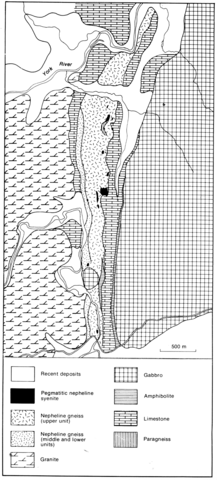stripes
In the townships of Dungannon and Monteagle a a narrow north- south-trending belt of nepheline gneisses follows the valley of the York River. The nepheline gneiss band differs from other nepheline syenites of the Bancroft area in the abundance of mafic facies, and by the fact that structurally it is overlain and underlain by marble and is separated from the main mixed gneiss complex of hybrid syenitic and granitic rocks, so that replacement textures and primary mineral assemblages have been preserved which appear to indicate that the nepheline-bearing rocks were produced by metasomatism of calcareous sediments. The nepheline gneiss band varies between 150 and 300 m in width and has an overall length of about 10 km. It dips 30-65° east, is enveloped in marble for most of its length, and encloses thin bands of marble. Eastwards the marble is overlain by a narrow zone of paragneiss and amphibolite followed by the Mallard Lake metagabbro. To the west the footwall marble is underlain by the Great Bend granite. The nepheline gneisses can be divided into three units: the lowermost contains little nepheline, is rich in feldspar including microcline, and biotite is the principal ferromagnesian mineral; scapolite is abundant. The middle unit comprises nepheline, plagioclase, garnet and ferrosalite, which is characteristic of this unit. The upper unit is generally rich in nepheline and poor in plagioclase, with hornblende as the characteristic ferromagnesian mineral. Plagioclase varies from An4 to An20 throughout the gneiss and calcite, diopside and idocrase occur at some levels. Detailed petrographic descriptions based principally on drill core will be found in Barager (1953) and Tilley (1958). Pegmatitic bodies occur throughout the gneiss, some of the larger ones being indicated on the accompanying map (Fig. 2_52). The Goulding-Keene pegmatite, which consists predominantly of nepheline and albite, with minor K-feldspar, biotite, calcite, cancrinite, sodalite and zircon, has been described in detail by Reeve and Anderson (1976) who agree with earlier authors that metasomatism was important in the generation of the pegmatites, a conclusion with which Sylvester and Anderson (1976) generally concur as a result of their work on the Davis pegmatite.
BARAGER, W.R.A. 1953. Nepheline gneisses of York River, Ontario. Proceedings of the Geological Association of Canada, 6(1): 83-111.
HEWITT, D.F. 1961. Nepheline syenite deposits of southern Ontario. Annual Report, Ontario Department of Mines, 69(8): 1-194.
BARAGER, W.R.A. 1953. Nepheline gneisses of York River, Ontario. Proceedings of the Geological Association of Canada, 6(1): 83-111.
REEVE, E.J. and ANDERSON, G.M. 1976. The Goulding-Keene nepheline pegmatite near Bancroft, Ontario. Canadian Journal of Earth Sciences, 13: 237-48.
SYLVESTER, G.C. and ANDERSON, G.M. 1976. The Davis nepheline pegmatite and associated nepheline gneisses near Bancroft, Ontario. Canadian Journal of Earth Sciences, 13: 249-65.
TILLEY, C.E. 1958. Problems of alkali rock genesis. Quarterly Journal of the Geological Society of London, 173: 323-60.

